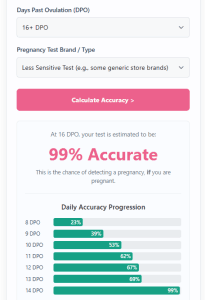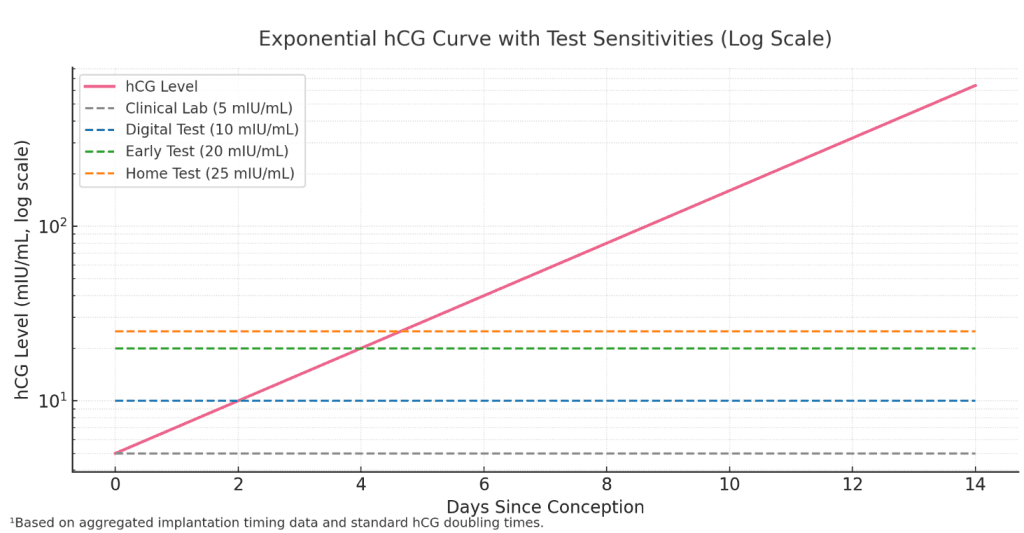Enter your DPO or LMP dates, choose your test brand, and see the estimated percent accuracy for detecting pregnancy on each day.
Pregnancy Test Accuracy Calculator
Estimate your test’s ability to detect pregnancy based on when you test and the test type.
How to Use This Calculator
Get your personalized accuracy estimate in just a few clicks.
- Select Your DPO: Choose your current Days Past Ovulation (DPO). If you’re unsure, this is the number of days since you ovulated. A typical cycle has ovulation around 14 days before an expected period.
- Choose Your Test: Select the brand or type of test you used from the dropdown. We’ve grouped them by their sensitivity.
- Calculate Your Accuracy: Click the button to see the estimated accuracy for today and a chart showing how the odds increase over the next few days.

The Science Behind Test Accuracy: All About hCG
A pregnancy test isn’t magic; it’s a simple science experiment. Its accuracy depends entirely on detecting one specific hormone: Human Chorionic Gonadotropin (hCG).
- What is hCG? Often called “the pregnancy hormone,” hCG is produced by the placenta shortly after the embryo implants into the uterine wall. Its job is to tell your body to continue supporting the pregnancy.
- How hCG Rises: Once production starts, hCG levels rise exponentially, typically doubling every 48-72 hours in the first few weeks. It starts at nearly zero and skyrockets.
- Test Sensitivity (mIU/mL): Every pregnancy test has a sensitivity level, measured in milli-international units per milliliter (mIU/mL). This number is the minimum amount of hCG the test needs to detect in your urine to show a positive result. A “highly sensitive” test like First Response Early Result (FRER) can detect hCG at very low levels (around 6 mIU/mL), while a standard test might require 25 mIU/mL or more.
A test is only accurate when your body’s hCG level has risen above your test’s sensitivity threshold. This is why testing too early is the #1 reason for a “false negative”—your body may be producing hCG, but not enough for the test to pick it up yet.

If you test very early, a blood beta-hCG can confirm and show change over time. Try the hCG doubling time calculator to see whether your hCG is increasing at a typical rate.
Frequently Asked Questions
What does a faint line mean?
A faint positive line almost always means you are pregnant. It indicates that the test has detected hCG in your urine, but the concentration is still low. This is very common in early testing. To confirm, test again in 48 hours; the line should become noticeably darker as your hCG levels double.
Why was my test negative? Am I out?
Not necessarily! The most common reason for a negative test is simply testing too early. As our calculator’s chart shows, accuracy jumps significantly between 9 and 14 DPO. Another factor is diluted urine. For the most reliable result, use your first-morning urine (FMU), as it’s the most concentrated.
What is a “false positive”?
A true false positive is extremely rare. They can be caused by certain fertility medications containing hCG, recent pregnancy loss (including a chemical pregnancy), or a handful of rare medical conditions. In most cases, a positive result—even a faint one—is a reliable indicator of pregnancy.
How soon can I really test for pregnancy?
While some highly sensitive tests may show a positive result as early as 8 or 9 DPO, the result is far more likely to be a false negative. For the most reliable outcome, it is best to wait until at least 12 to 14 DPO, or the day of your expected period.
Which pregnancy test is the best one to use?
It depends on your goal.
- For Early Results: Highly sensitive tests like First Response Early Result (FRER) are the gold standard for testing before your missed period.
- For Value: If you are a frequent tester, inexpensive and reliable strips like Easy@Home or Wondfo are excellent choices. They are slightly less sensitive than FRER but very accurate from the day of your missed period.
- For Clarity: Digital tests like Clearblue Digital remove the guesswork of interpreting lines, giving you a clear “Pregnant” or “Not Pregnant” result.
This information is for educational purposes and is not a substitute for professional medical advice. Always confirm a home pregnancy test result with a healthcare provider.
